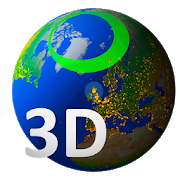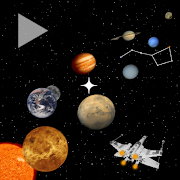
Description
App Information Earth
- App NameEarth
- Package Namecom.infoappzbrew.earth
- UpdatedAugust 4, 2021
- File Size24M
- Requires AndroidAndroid 4.1 and up
- Version1.3
- DeveloperGeneralKnowledge
- Installs5,000+
- PriceFree
- CategoryBooks & Reference
- DeveloperLorong 1 26400 Bandar Jengka Pahang Malaysia
- Google Play Link
GeneralKnowledge Show More...
Moon 1.3 APK
The Moon is Earth's only permanent natural satellite. It is one ofthe largest natural satellites in the Solar System, and the largestamong planetary satellites relative to the size of the planet thatit orbits (its primary). It is the second-densest satellite amongthose whose densities are known (after Jupiter's satellite Io). TheMoon is thought to have formed approximately 4.5 billion years ago,not long after Earth. There are several hypotheses for its origin;the most widely accepted explanation is that the Moon formed fromthe debris left over after a giant impact between Earth and aMars-sized body called Theia. The Moon is in synchronous rotationwith Earth, always showing the same face with its near side markedby dark volcanic maria that fill between the bright ancient crustalhighlands and the prominent impact craters. It is thesecond-brightest regularly visible celestial object in Earth's skyafter the Sun, as measured by illuminance on Earth's surface. Itssurface is actually dark (although it can appear a very brightwhite) with a reflectance just slightly higher than that of wornasphalt. Its prominence in the sky and its regular cycle of phaseshave made the Moon an important cultural influence since ancienttimes on language, calendars, art, and mythology. The Moon'sgravitational influence produces the ocean tides, body tides, andthe slight lengthening of the day. The Moon's current orbitaldistance is about thirty times the diameter of Earth, with itsapparent size in the sky almost the same as that of the Sun,resulting in the Moon covering the Sun nearly precisely in totalsolar eclipse. This matching of apparent visual size will notcontinue in the far future. The Moon's linear distance from Earthis currently increasing at a rate of 3.82 ± 0.07 centimetres (1.504± 0.028 in) per year, but this rate is not constant. The SovietUnion's Luna programme was the first to reach the Moon withunmanned spacecraft in 1959; the United States' NASA Apollo programachieved the only manned missions to date, beginning with the firstmanned lunar orbiting mission by Apollo 8 in 1968, and six mannedlunar landings between 1969 and 1972, with the first being Apollo11. These missions returned over 380 kg (840 lb) of lunar rocks,which have been used to develop a geological understanding of theMoon's origin, the formation of its internal structure, and itssubsequent history. After the Apollo 17 mission in 1972, the Moonhas been visited only by unmanned spacecraft.
Learn All Dinosaur Species 1.9 APK
Dinosaurs are a diverse group of animals of the clade Dinosauria.They first appeared during the Triassic period, 231.4 million yearsago, and were the dominant terrestrial vertebrates for 135 millionyears, from the start of the Jurassic (about 200 million years ago)until the end of the Cretaceous (66 million years ago), when theCretaceous–Paleogene extinction event led to the extinction of mostdinosaur groups at the end of the Mesozoic Era. The fossil recordindicates that birds are modern feathered dinosaurs, having evolvedfrom theropod ancestors during the Jurassic Period.Some birdssurvived the extinction event that occurred 66 million years ago,and their descendants continue the dinosaur lineage to the presentday. Features : - An easy way to share with friends; - AutomaticFree Updates - Available in many languages - Can Change BackgroundColour - Compatible with modern versions of Android devices -Ebook/E-reader - The dictionary works offline - you do not need aninternet connection. Access to articles (descriptions) offline,without an Internet connection - Very efficient, fast and goodperformance - Very quick search for descriptions This applicationAvailable in 13 languages : 1.Arabic language (العربية) 2.Englishlanguage (US/UK) 3.French language (Français) 4.German language(Deutsch) 5.Hindi language (हिन्दी) 6.Indonesian language (BahasaIndonesia) 7.Italiano language 8.Malay language (Bahasa Melayu)9.Persian language (فارسی) 10.Português language (Brazil/Portugal)11.Russian language (Русский) 12.Spanish language (Español)13.Turkish language (Türkçe) Note : This application is develop foreducational purpose. All images in this application are theproperty of their respective owners, and usage in this applicationfalls within guidelines of "fair use".
Megalodon 1.2 APK
Megalodon , meaning "big tooth", from Ancient Greek: μέγας(megas)"big, mighty" and ὀδoύς (odoús), "tooth"—whose stem isodont-, asseen in the genitive case form ὀδόντος, odóntos)[1] is anextinctspecies of shark that lived approximately 23 to 2.6 millionyearsago, during the Cenozoic Era (early Miocene[2] to endofPliocene[3]). The taxonomic assignment of C. megalodon hasbeendebated for nearly a century, and is still under dispute. Thetwomajor interpretations are Carcharodon megalodon (underfamilyLamnidae) or Carcharocles megalodon (under thefamilyOtodontidae).[4] Consequently, the scientific name of thisspeciesis commonly abbreviated C. megalodon in the literature.
Learn Mars 1.2 APK
Mars is the fourth planet from the Sun and the second-smallestplanet in the Solar System, after Mercury.Often referred to as the"Red Planet"[13][14] because the iron oxide prevalent on itssurface gives it a reddish appearance.[15] Mars is a terrestrialplanet with a thin atmosphere, having surface features reminiscentboth of the impact craters of the Moon and the valleys, deserts,and polar ice caps of Earth. The rotational period and seasonalcycles of Mars are likewise similar to those of Earth, as is thetilt that produces the seasons. Mars is the site of Olympus Mons,the largest volcano and second-highest known mountain in the SolarSystem, and of Valles Marineris, one of the largest canyons in theSolar System. The smooth Borealis basin in the northern hemispherecovers 40% of the planet and may be a giant impact feature.[16][17]Mars has two moons, Phobos and Deimos, which are small andirregularly shaped. These may be captured asteroids,[18][19]similar to 5261 Eureka, a Mars trojan. Until the first successfulMars flyby in 1965 by Mariner 4, many speculated about the presenceof liquid water on the planet's surface. This was based on observedperiodic variations in light and dark patches, particularly in thepolar latitudes, which appeared to be seas and continents; long,dark striations were interpreted by some as irrigation channels forliquid water. These straight line features were later explained asoptical illusions, though geological evidence gathered by uncrewedmissions suggests that Mars once had large-scale water coverage onits surface at some earlier stage of its existence.[20] In 2005,radar data revealed the presence of large quantities of water iceat the poles[21] and at mid-latitudes.[22][23] The Mars roverSpirit sampled chemical compounds containing water molecules inMarch 2007. The Phoenix lander directly sampled water ice inshallow Martian soil on July 31, 2008.[24] On September 28, 2015,NASA announced the presence of briny flowing salt water on theMartian surface.[25]
Guide for Fallout 4 1.6 APK
Guide for Fallout 4 for PC and all console. Notes : This app isfanmade and unofficial guide to the "Fallout 4" videogame series.Itis not affiliated to the games' publishers or developers.Allcharacters, locations, and images of game logos are the propertyoftheir respective owners, and usage in this guide fallswithinguidelines of "fair use".
Mammoth 1.2 APK
A mammoth is any species of the extinct genus Mammuthus,proboscideans commonly equipped with long, curved tusks and, innorthern species, a covering of long hair. They lived from thePliocene epoch (from around 5 million years ago) into the Holoceneat about 4,500 years ago[1][2] in Africa, Europe, Asia, and NorthAmerica. They were members of the family Elephantidae, which alsocontains the two genera of modern elephants and their ancestors.Mammoths stem from an ancestral species called M. africanavus, theAfrican mammoth. These mammoths lived in northern Africa anddisappeared about 3 or 4 million years ago. Descendants of thesemammoths moved north and eventually covered most of Eurasia. Thesewere M. meridionalis, the 'southern mammoths'.
Similar Apps Show More...
Solar Walk Lite - Planetarium 3D: Planets System 2.7.5 APK
An awesome 3D model of our solar system foryou to explore space! Solar Walk Lite - Planetarium app 3Dis a time-sensitive solar system and space simulator showing thereal orbits, order, scale and motion of the Sun, allowing you toexplore all the 8 planets in real time, more than 20 moons, dwarfs,asteroids, comets, 9 Earth satellites, 9 dwarf planets and morethan 50 stars. You can find and explore any celestial body withthis amazing solar system app!***BEST OF 2016***The Lite version of the well-known space simulator is absolutelyfree, ad-supported and very small in size but contains all the mainfeatures and objects (stars, planets and moons, satellites, etc) ofour solar system.NO INTERNET CONNECTION IS REQUIRED!Explore space and get a little closer to our wonderful universewith this awesome 3d model of our solar system!Exploration of our solar system has never been so easy andentertaining!🚀Planets and stars app - Main Features:💫 Space simulator: realistic space view with real-time positions,order, size, inner structure of solar system planets and moons,their orbits, stars, comets, satellites and other celestialbodies.💫 Every planet and celestial body has an extensive information:size, mass, orbital velocity, exploratory missions, thickness ofstructural layers, and photo gallery with real photos taken bytelescopes or NASA spacecrafts during the space missions.💫 Orrery Mode on/off - to see the schematic or realistic sizes anddistances between the solar system objects.💫 Anaglyph 3D on/off - if you have anaglyph 3D glasses you canchoose this option to navigate through the solar system and enjoythe beauty of space and solar system planets.💫 Zoom-in to see objects in close up and Zoom-out to see theposition of our solar system in Galaxy.💫 Planets 3D and 3D models of spacecraft in the application arebased on scientific data collected by ESA and NASA spacecrafts andground based telescopes.The best encyclopedia of the solar system!This is a great planetarium 3D, solar system app for the spaceexplorers. It works great for both kids and adults. Kids lovelearning about the planets, and the amazing graphics andinformation provided in this space simulator makes it engaging andcaptivating. Kids will also enjoy "travel" through space to get anup-close view of the planets, moons, and stars. In fact, adults maynot be able to put this app down either!This space simulator is excellent for teachers to use forinstruction, and it is a great resource for students to exploreplanets and space as they learn more about the universe we live in.With Solar Walk Lite - Planetarium app 3D you dont need atelescope to see the planets for real. Find sun, moon, planets andstars location in the planetarium app free.This 3D model of our solar system is a must-have for all spaceenthusiasts! Explore space with Solar Walk Lite!Main Objects to explore with solar system 3D simulator:Planets: Mercury, Venus, Earth, Mars, Jupiter, Saturn,Uranus, Neptune.Moons: Phobos, Deimos, Callisto, Ganymede, Europa, Io,Hyperion, Iapetus, Titan, Rhea, Dione, Tethys, Enceladus, Mimas,Oberon, Titania, Umbriel, Ariel, Miranda, Triton, Larissa, Proteus,Nereid, CharonDwarf planets and asteroids: Pluto, Ceres, Makemake, Haumea,Sedna, Eris, ErosComets: Hale-Bopp, Borrelly, Halley’s Comet,Ikeya-ZhangSatellites: SEASAT, ERBS, Hubble Space Telescope,International Space Station (ISS), Aqua, Envisat, Suzaku, Daichi,CORONAS-PhotonStars: Sun, Sirius, Betelgeuse, Rigel Kentaurus.Get this solar system, planets and stars app now free and explorespace with us!
Books & Reference Top Show More...
Malayalam bible ( ബൈബിൾ ) 2.6 APK
Malayalam Bible is the First everMaterialdesign Malayalam Bible in Android. Free Malayalam bible hasgot allchapter of old testament and New testament in Malayalamstandard,with a legitimate reading . UI is designed for easynavigationcapabilities. It provides daily Malayalam biblereadingnotification and tracks all the read chapters. As a part ofBibleorg we are glad to release android Malayalam Bible app as afreeservice, to spread Jesus words. We welcome any suggestionstoimprove yourself. Start your day with Malayalam of thebible.Malayalam bible download app is not just another MalayalambibleStudy app. Its for Malayalam people from Kerala. Our aim is tokeepyou inspired and nourished everyday with god words .You willgetautomatic daily notification. Mark the Inspiring MalayalamBibleverse! As a christian, we have verified the chapters of holybiblereading with international standard. Malayalam bible onlineLiteapp, always tracks the unread chapter for daily biblereading.Clean font, helps to read letters easily. Our chosen dailybiblereading in Malayalam helps you to start your day thinkingabout andthanking God for this wonderful life with prayers. FreeMalayalambible download study bible helps to enlighten beforeconfession andalso a as bible study app or even liturgy. The HolyBible inMalayalam will be very helpful during daily MalayalamChristianprayer. Bible in Malayalam is for kids, Download MalayalamBibleapp is for couples, and Holy Malayalam Bible is for allChristianssuch as Syro malabar christian, RC Christian, KananaChristian,Orthodox Christian , syro malankara christians, Syrianchristiansacross globe. Malayalam Bible study follows the popularbibleversions like the POC bible, Malayalam bible offline -kjv,Complete BibleYouth Bible, Acts of the Apostles, letters,andApocalypse, (New India Bible Version) in Malayalam , ewestCompleteMalayalam version Vishudha Sathyavedapusthakam, and otherpopularversion of bible in Malayalam including catholic Malayalambible.So this daily Malayalam Bible study devotion app will be thebestbible app free that you will get for your Android mobilephones.Bible translations into Malayalam- Malayalam bible App ,understandits right meaning and act wisely upon so as to bringhappiness uponon yourself and your fellow beings to enlightenfaith. This iscomplete Malayalam bible. Malayalam bible downloadapp can also beused during Malayalam audio bible reading. Mark thefavoriteMalayalam bible quotes and chapter for future reference,set it asFavorites by click. Malayalam Divine app is also used asthe bestMalayalam devotionals for women. Our india Malayalam bible- TheDaily devotional Malayalam Bible app can be used foryouthfulpraise or as youth ministry resources, because we gave thebestMalayalam bible gateway for Youth. Our future effort will betoinclude sandhya prarthana malayalam, Kurushe vara prayers,saintsprayers in Malayalam, along with different christiancommunitymalayalam kurbana.FEATURE OF Malayalam BIBLE ( Material design )- Material design UI- Ability to save favorite chapters or verses.- Enable/Disable Notification settings- Daily Malayalam Bible Reading :Get on daily basis biblereading(- Holy Bible Malayalam with old testament and New testament- Compatible with all screen sizes- Get daily bible reading and track the read chapters.- Ease and simple to use.- Download latest design bible compatible with tablet- Always provide unread chapters for notification- Bible offline - Read bible even without network access.- Works well in android phone and tablet- Explore specific words in bible- Easily locate Book/Chapter/Verse- This is a free Lite app Malayalam Bible .- Read, Remove, Share with ease.This app is successfully tested in samsung galaxy series,LGnexus, HTC, Lenova smart phones. Its works well in tablets tooandall mobile phone which support android.
Auradu wal Manaqib (OLD) 2 APK
This App help you to Read most ofMaulid,Dikr,Dua, Swalath, Baith, Malappattu ect..This app ContainsSharaful Anam MaulidManqoos MaulidHaddadDua-al-KabarDuaAshrakal BaithMajlisunnoor Baith and DuaYaseenBadar BaithThwala'al Badaru BaithSalam BaithYaa akramal BaithAizamu SwalathAuradu Majlisu SwalathThaju SwalathNariyath SwalathHaddadAsmaul HusnaMayyith niskaramect..its a Complete Adkar Kitab.App created By SKSSF Cyber wing State Committee(an SKSSF Silver Jubilee Grand Finale Gift)
Punjabi Bible ( ਬਾਇਬਲ ) 2.2 APK
Punjabi Bible is the First everMaterialdesignPunjabi Bible in Android. Free Punjabi bible has gotallchapter ofold testament and New testament in Punjabistandard,with alegitimate reading. UI is designed for easynavigationcapabilities.It provides daily Punjabi bible readingnotificationand tracks allthe read chapters. As a part of Bible orgwe areglad to releaseandroid Punjabi Bible app as a free service,tospread Jesus words.We welcome any suggestions to improveyourself.Start your day withPunjabi of the bible. Punjabi bibledownloadapp is not just anotherPunjabi bible Study app (PunjabiLanguage).Its for Punjabi peopleof India and for the entire PunjabispeakingPeople community inPunjab or any part of India. Our aim isto keepyou inspired andnourished everyday with god words .You willgetautomatic dailynotification using christian Punjabi bible.Markthe InspiringPunjabi Bible verses ! Punjabi bible online Liteapp,always tracksthe unread chapter for daily bible reading.Cleanfont, helps toread letters easily. Pavitra Bible, mobilephonePunjabi bible.Punjabi Bible Online helps you to start yourdaythinking about andthanking God for this wonderful lifewithprayers. Free Punjabibible download study bible helps toenlightenbefore confession andalso a as bible study app or evenliturgy.The Bible in Punjabi willbe very helpful during dailyPunjabiChristian prayer. Bible inPunjabi is for kids, Holy BibleinPunjabi is for couples and HolyPunjabi Bible for allChristiansacross globe including Punjabispeaking community. PunjabiBiblefollows the popular bible versionslike the Catholic Punjabibible,very similar to Hindi Bible. Sothis daily Punjabi Biblestudydevotion app ( Punjabi Book) will bethe best bible app freethatyou will get for your Android mobilephones. This Punjabi bible,understand its right meaning and actwisely upon so as tobringhappiness upon on yourself and yourfellow beings toenlightenfaith.Punjabi language bible stories foryouth in Punjabi -Punjabibible download app can also be usedduring Punjabi audiobiblereading. - Punjabi Holy Bible, Mark thefavorite Punjabibiblequotes and chapter for future reference, setit as Favoritesbyclick. Punjabi Divine app is also used as thebestPunjabidevotionals for women.The Daily devotional PunjabiBible appcan beused for youthful praise or as youth ministryresources,because wegave the best Punjabi bible gateway for Youth.FEATURE OF Punjabi BIBLE ( Material design )- Material design UI- Ability to save favorite chapters or verses.- Enable/Disable Notification settings- Daily Punjabi Bible Reading :Get on daily basisbiblereading- Holy Bible Punjabi with old testament and New testament- Compatible with all screen sizes- Get daily bible reading and track the read chapters.- Ease and simple to use.- Download latest design bible compatible with tablet- Always provide unread chapters for notification- Punjabi Bible offline - Read bible evenwithoutnetworkaccess.- Works well in android phone and tablet- Explore specific words in bible- Easily locate Book/Chapter/Verse- This is a free Lite app Punjabi Bible .- Read, Remove, Share with ease.This app is successfully tested in tablets and smartphone.Itsworks well in tablets too and all mobile phonewhichsupportandroid.
Kabir Dasji Ke Dohe in Hindi 2.0 APK
Kabir Dasji Ke Dohe in HindiKabir was a poet and a saint, whose coupletsstillresonatewithpeople from all walks of life.Born in the early 15th century to a Brahman widow, hewasbroughtupin a family of Muslim weavers.While his date of birth and death arenotfirmlyestablished,legend has it that he lived for a 120years.Never formally educated, and almostcompletelyilliterate,hiscompositions are nevertheless aphilosophicalgoldmine.This App is a compilation of 200+ 'Kabir ke Done'twolinecoupletswith that meaning.A very user friendly interface and supportsallmajorAndroidOperating systems(GingerBread to Lollipop vers)This App also has a feature to share the Dohe onSocialmediaLikeWhtsapp.
বাণী চিরন্তনী Bani Chirontoni 1.2 APK
বিখ্যাত মনীষীদের জনপ্রিয় উক্তিনিয়েঅ্যাপটিতৈরিকরা হয়েছে।যাদের উক্তি নিয়ে অ্যাপটি তৈরি করা হয়েছে -আল হাদিস, হযরত আলী (রাঃ) ,বিল গেটস ,আব্রাহামলিংকন,অ্যালবার্টআইনস্টাইন, সক্রেটিস , এরিস্টটল, শেখ সাদি ,স্টিভজবস,উইলিয়ামশেক্সপিয়র ,স্বামী বিবেকানন্দ , শেখ মুজিবুর রহমান,হুমায়ূনআহমেদ,রবীন্দ্রনাথ ঠাকুর ,কাজী নজরুল ইসলাম, গৌতমবুদ্ধ,মহাত্মা গান্ধী , এ পি জে আব্দুল কালাম , লালন ।The app hasbeencreatedbythe great scholars of the popular saying.Quote of the app has been created -Al-hadith, Hazrat Ali (RA), Bill Gates,AbrahamLincoln,AlbertEinstein, Socrates, Aristotle, Sheikh Saadi,SteveJobs,WilliamShakespeare, Swami Vivekananda, SheikhMujiburRahman,HumayunAhmed, Rabindranath Tagore, Kazi NazrulIslam,GautamaBuddha,Mahatma Gandhi, APJ Abdul Kalam, cherish.
Tamil Bible (வேதாகமம்) 3.9 APK
Tamil Bible is the First everMaterialdesignTamil Bible in Android. Free Tamil bible has got allchapterof oldtestament and New testament in Tamil standard, withalegitimatereading . UI is designed for easynavigationcapabilities. Itprovides daily Tamil bible readingnotification andtracks all theread chapters. As a part of Bible orgwe are glad toreleaseandroid Tamil Bible app as a free service, tospread Jesuswords.We welcome any suggestions to improve yourself.Start yourday withTamil of the bible. Tamil bible download app isnot justanotherTamil bible Study app (Tamil Language). Its forTamil peopleofTamil Nadu. Our aim is to keep you inspired andnourishedeverydaywith god words .You will get automatic dailynotificationusingchristian tamil bible. Mark the Inspiring TamilBible verse!As achristian, we have verified the chapters of holybible readingwithinternational standard. Tamil bible online Liteapp, alwaystracksthe unread chapter for daily bible reading. Cleanfont, helpstoread letters easily. Our chosen daily bible readingarulvakku-Tamil Bible Online helps you to start your day thinkingaboutandthanking God for this wonderful life with prayers. booksoftamilbible, Free Tamil bible download study bible helpstoenlightenbefore confession and also a as bible study app orevenliturgy.The Bible - Sacred text will be very helpful duringdailyTamilChristian prayer.Bible in Tamil is for kids, Holy Bibleintamil isfor couples and Holy Tamil Bible for all Christiansacrossglobe.Tamil Bible follows the popular bible versions liketheCatholicTamil bible , Tamil Union Version Bible,TamilBible:Easy-to-ReadVersion (ERV-TA),kjv tamil bible. So this dailyTamilBible studydevotion app will be the best bible app free thatyouwill get foryour Android mobile phones. This Tamil bible,understand its rightmeaning and act wisely upon so as tobringhappiness upon onyourself and your fellow beings toenlightenfaith. bible storiesfor youth in tamil - Tamil bibledownload appcan also be usedduring Tamil audio bible reading. Markthe favoriteTamil biblequotes and chapter for future reference, setit asFavorites byclick. Tamil Divine app is also used as the bestTamildevotionalsfor women.The Daily devotional Tamil Bible app canbeused foryouthful praise or as youth ministry resources, becausewegave thebest Tamil bible gateway for Youth.FEATURE OF Tamil BIBLE ( Material design )- Material design UI- Ability to save favorite chapters or verses.- Enable/Disable Notification settings- Daily Tamil Bible Reading :Get on daily basis bible reading- Holy Bible Tamil with old testament and New testament- Compatible with all screen sizes- Get daily bible reading and track the read chapters.- Ease and simple to use.- Download latest design bible compatible with tablet- Always provide unread chapters for notification- Bible offline - Read bible even without network access.- Works well in android phone and tablet- Explore specific words in bible- Easily locate Book/Chapter/Verse- This is a free Lite app Tamil Bible .- Read, Remove, Share with ease.This app is successfully tested in samsung galaxyseries,LGnexus, HTC, Lenova smart phones. Its works well in tabletstooandall mobile phone which support android.
Pixelmon MOD MCPE 0.15.0 2.0 APK
Pixelmon Mod for Minecraft PE ofmanythingsfrom the show, including Pokemon, gym badges, andbattling.This Pixelmon Mod for Minecraft PE can only beappliedwithBlockLauncher application and you need install the fullversionofMCPE and BlockLauncher in your smartphone or tablet.This is an unofficial application for Minecraft PocketEdition.Thisapplication is not affiliated in any way with MojangAB.TheMinecraft Name, the Minecraft Brand and the MinecraftAssetsareall property of Mojang AB or their respectful owner.Allrightsreserved. Inaccordancewithhttp://account.mojang.com/documents/brand_guidelinesPixelmon Mod for Minecraft PE is pack of mod it have manymodinthis appEvery mod has title, description , screenshot anddownloadbutton.Search any mods for mcpe you want just browsefavourite modandpress DOWNLOAD ... Done!A fun feature of Pixelmon Mod for Minecraft PE is thatyoucancatch Pokemon in a 3D poke ball, and even see yourPokemon'suniqueattributes which consist of habits,damage, armor and aggression. This isnt just a cosmeticmodthatgives facelifts to models already existing in thegamePixelmonactually includes an attack system ripped rightfromPixelmon Modfor Minecraft PE, with over 500 individual attackmovesand evenstatus ailments, to make it play and feel much likethehandheldPokemon games. This Pixelmon Mod for Minecraft PEevenafunctioning pokedex for keeping track of what monsterstheplayerhas caught!
Yasin Dan Tahlil "LENGKAP" 5.0 APK
Surat Yasin Dan Bacaan TahlilBesertaTerjemahanTeks Arab Dan Teks Latinnya Lengkap DenganBahasaIndonesianyaUpdate Versi 5.0 :- Penambahan Audio Di Setiap Surat- Memperbaiki Semua Bacaan Yasin Baik ArabTulisanMaupunTerjemahannya- Penambahan Doa Tahlil- Penambahan Doa Selamat- Penambahan Doa Ayat Kursi- Penambahan Doa Ziarah Kubur- Penambahan Doa Khusus Mayit- Penambahan Surat Al-Fatihah- Penambahan Surat Al-Ikhlas- Penambahan Surat Al-Falaq- Penambahan Surat An-Nas- Penambahan Surat Al-Baqarah : Ayat 1 - 5- Penambahan Doa Selamat- Bug Fix Error DLL------------------------------------------------------------- Tulisan Font Arab Besar Dan Juga Dapat DiZoomSesuaiKeinginan- 100% Aplikasi SUPER RINGAN- Aplikasi 100% Bisa Dibaca TanpaMenggunakanKoneksiInternet.- 100% Insya Allah Bermanfaat :)Surah YasinandTahlilReading Text Translation Along with Arab and LatinTextCompleteWith Indonesian languageUpdate Version 5.0:- Addition Audio On Any Letter- Improve Reading Yasin Good All Posts Nor Arabic translation- Addition of Prayer Tahlil- Addition of Prayer Welcome- Addition of Prayer Ayat Kursi- Addition of Prayer Pilgrimage Kubur- Addition of Special Prayer Mayit- Addition of Surat Al-Fatihah- Addition of Surat Al-Ikhlas- Addition of Surat Al-Falaq- Addition of Surat An-Nas- Addition of Surat Al-Baqarah: Verse 1-5- Addition of Prayer Welcome- Bug Fix DLL Error------------------------------------------------------------- Writing Arabic Font Large And Can Also Be In ZoomInaccordanceDesire- 100% Applications SUPER LIGHTWEIGHT- 100% Applications Can Read WithoutUsingInternetConnection.- 100% Inshallah Helpful :)

























